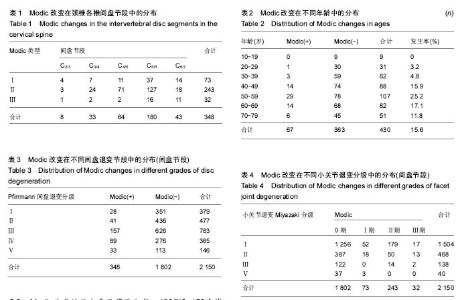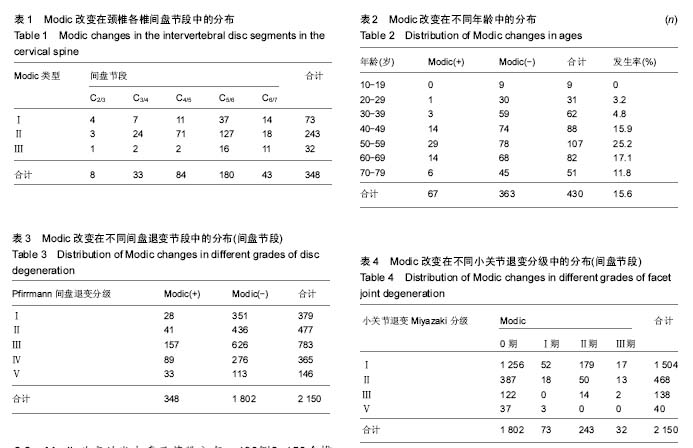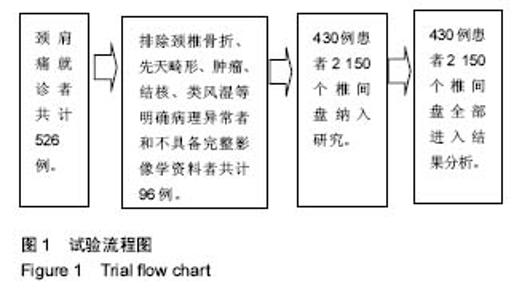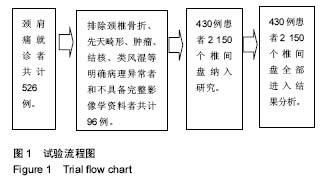Chinese Journal of Tissue Engineering Research ›› 2018, Vol. 22 ›› Issue (3): 432-437.doi: 10.3969/j.issn.2095-4344.0043
Previous Articles Next Articles
Distribution of Modic changes and its relationship with cervical degeneration in patients with neck and shoulder pain
Li Wen-xuan1, Yu Bao-long1, Zhang Pei1, Li Rui-feng1, Jia Yan-bo2
- 1Department of Cervical Spine Surgery, 2Department of Orthopedics, the Second Affiliated Hospital of Inner Mongolia Medical University, Hohhot 010030, Inner Mongolia Autonomous Region, China
-
Online:2018-01-28Published:2018-01-28 -
Contact:Zhang Pei, Chief physician, Professor, Master’s supervisor, Department of Cervical Spine Surgery, the Second Affiliated Hospital of Inner Mongolia Medical University, Hohhot 010030, Inner Mongolia Autonomous Region, China -
About author:Li Wen-xuan, Master, Attending physician, Department of Cervical Spine Surgery, the Second Affiliated Hospital of Inner Mongolia Medical University, Hohhot 010030, Inner Mongolia Autonomous Region, China Yu Bao-long, Master, Attending physician, Department of Cervical Spine Surgery, the Second Affiliated Hospital of Inner Mongolia Medical University, Hohhot 010030, Inner Mongolia Autonomous Region, China Li Wen-xuan and Yu Bao-long contributed equally to this work. -
Supported by:the Natural Science Foundation of Inner Mongolia Autonomous Region, No. 2015MS0895
CLC Number:
Cite this article
Li Wen-xuan, Yu Bao-long, Zhang Pei, Li Rui-feng, Jia Yan-bo. Distribution of Modic changes and its relationship with cervical degeneration in patients with neck and shoulder pain[J]. Chinese Journal of Tissue Engineering Research, 2018, 22(3): 432-437.
share this article
Add to citation manager EndNote|Reference Manager|ProCite|BibTeX|RefWorks

2.2 Modic改变的发生率及节段分布 430例2 150个椎间盘中共有67例(15.6%)348个(16.2%)椎间盘节段发生Modic改变,其中Ⅰ型73个(3.4%),Ⅱ型243个(11.3%),Ⅲ型32个(1.5%)。应用多组频数分布的卡方检验,各组间差异有显著性意义(χ2=34.39,P < 0.01),Modic改变最好发于C5/6节段,见表1。 2.3 Modic改变在不同年龄中的分布 应用多组频数分布的卡方检验,Modic改变的发生率在10-39岁3组间差异无显著性意义(χ2=0.55,P > 0.05),在40-79岁4组间差异亦无显著性意义(χ2=6.98,P > 0.05);10-39岁的3组和40-79岁的4组间发生率差异有显著性意义(χ2=22.21,P < 0.01),Modic改变在40岁以上多见,见表2。 2.4 Modic改变的性别分布特点 本组430例患者中男性223例,Modic改变阳性者39例,女性207例,Modic改变阳性者28例,应用卡方检验,Modic改变在不同性别间的发生率差异无显著性意义(χ2=1.28,P > 0.05)。 2.5 Modic改变与间盘退变的关系 应用多组频数分布的卡方检验,Pfirrmann间盘退变Ⅰ级和Ⅱ级2组间发生率的差异无显著性意义(χ2=0.42,P > 0.05),Ⅲ级至Ⅴ级3组间差异亦无显著性意义(χ2=2.87,P > 0.05),Ⅰ、Ⅱ级2组和Ⅲ-Ⅴ级3组间差异有显著性意义(χ2=73.02,P < 0.01),Modic改变好发于Pfirrmann间盘退变Ⅲ期及以上的间盘节段,见表3。 2.6 Modic改变与颈椎后方小关节退变的关系 应用完全随机设计下多组频数分布的χ2检验,颈椎Modic各期改变与Miyazaki小关节退变分级之间无相关性(χ2=4.91,P > 0.05),见表4。 "

| [1] De Roos A, Kressel H, Spritzer C, et al. MR imaging of marrow changes adjacent to end plates in degenerative lumbar disk disease. Am J Roentgenol. 1987;149(3): 531-534.[2] Modic MT, Steinberg PM, Ross JS, et al. Degenerative disk disease: assessment of changes in vertebral body marrow with MR imaging. Radiology. 1988;166(1):193-199.[3] Zhang YH, Zhao CQ, Jiang LS, et al. Modic changes: a systematic review of the literature. Eur Spine J. 2008;17(10): 1289.[4] Miyazaki M, Hong SW, Yoon SH, et al. Reliability of a magnetic resonance imaging-based grading system for cervical intervertebral disc degeneration. J Spinal Disord Tech. 2008;21(4):288–292.[5] Kuisma M, Karppinen J, Niinimäki J, et al. Modic changes in endplates of lumbar vertebral bodies: prevalence and association with low back and sciatic pain among middle-aged male workers. Spine. 2007;32(10):1116-1122.[6] Martínezquiñones JV, Asoescario J, Gonzálezgarcía L, et al. Are Modic changes able to help us in our clinical practice? A study of the Modic changes in young adults during working age. J Spinal Disoder. 2017;30(6):259-264.[7] Tarukado K, Ono T, Tono O, et al. Does Modic change progress with age? Spine. 2017, DOI:10.1097/BRS.0000000000002254.[8] Tong T, Gao X D, Li J, et al. Do Modic changes affect cervical sagittal alignment and motion in symptomatic patients? Eur Spine J. 2017; 1-8.[9] Russo VM, Dhawan RT, Dharmarajah N, et al. Hybrid bone single photon emission computed tomography imaging in evaluation of chronic low back pain: correlation with Modic changes and degenerative disc disease. World Neurosurg. 2017;104:816-823.[10] Mok FP, Samartzis D, Karppinen J, et al. Modic changes of the lumbar spine: prevalence, risk factors and association with disc degeneration and low back pain in a large-scale population-based cohort. Spine J. 2015;16(1):32-41.[11] 李继刚,杨惠林,朱若夫,等.颈椎终板Modic改变分布特点与退变的关系[J].中国组织工程研究与临床康复,2011,15(13):2446-2449.[12] Sheng-Yun L, Letu S, Jian C, et al. Comparison of modic changes in the lumbar and cervical spine, in 3167 patients with and without spinal pain. Plos One. 2014;9(12): e114993.[13] Matsumoto M, Okada E, Ichihara D, et al. Modic changes in the cervical spine: prospective 10-year follow-up study in asymptomatic subjects. J Bone Joint Surg Br. 2012;94(5): 678-683. [14] Park MS, Moon SH, Kim TH, et al. Relationship between modic changes and facet joint degeneration in the cervical spine. Eur Spine J. 2015;24(12):2999-3004.[15] Peterson CK, Humphreys BK, Pringle TC. Prevalence of modic degenerative marrow changes in the cervical spine. J Manipulative Physiol Ther. 2007;30(1):5-10. [16] Portella ST, Acioly MA. The course of Modic vertebral body changes after posterolateral lumbar fusion on fused and adjacent levels: A systematic review of the literature. J Clin Neurosci. 2017;41:6-10.[17] 邹家生,苏建勇, 颈椎轴性疼痛患者Modic改变的MRI诊断价值[J]. 中国医师进修杂志, 2011, 34(32): 61-63.[18] Albert H, Manniche C. Modic changes following lumbar disc herniation. Eur Spine J. 2007;16(7):977-982.[19] Nguyen C, Jousse M, Poiraudeau S, et al. Intervertebral disc and vertebral endplate subchondral changes associated with Modic 1 changes of the lumbar spine: a cross-sectional study. BMC Musculoskelet Disord.2017; 23;18(1):34.[20] Huang ZY, Xu HC, Lei T, et al. The location of Modic changes in the lumbar spine: a meta-analysis. Eur Spine J. 2016; 25(11):1-14.[21] 赵凤东,丁献军,林伟,等. Modic改变在腰腿痛病例中的分布及相关因素分析[J].中华骨科杂志, 2007,27(3):172-176.[22] Karchevsky M, Schweitzer ME, Carrino JA, et al. Reactive endplate marrow changes: a systematic morphologic and epidemiologic evaluation. Skeletal Radiol. 2005;34(3): 125-129.[23] Kleinstück F, Dvorak J, Mannion AF. Are “Structural Abnormalities” on magnetic resonance imaging a contraindication to the successful conservative treatment of chronic nonspecific low back pain? Spine. 2006;31(19): 2250-2257.[24] Han C, Kuang MJ, Ma JX, et al. Prevalence of Modic changes in the lumbar vertebrae and their associations with workload, smoking and weight in northern China. Sci Rep. 2017;(7): 46341.[25] Albert H, Briggs A, Kent P, et al. The prevalence of MRI-defined spinal pathoanatomies and their association with Modic changes in individuals seeking care for low back pain. Eur Spine J. 2011;20(8):1355-1362.[26] Zhou H, Fan J, Sun P, et al. Correlation analysis between modic change of cervical vertebrae and intramedullary high signal intensity. Clin Spine Surg. 2017.DOI: 10.1097/BSD.0000000000000508.[27] Määttä JH, Macgregor A, Karppinen J, et al. The relationship between Modic changes and intervertebral disc degeneration. BMC Musculoskelet Disord. 2016;17(1):371.[28] Kerttula L, Luoma K, Vehmas T, et al. Modic type I change may predict rapid progressive, deforming disc degeneration: a prospective 1-year follow-up study. Eur Spine J. 2012;21(6): 1135-1142.[29] 刘珍珍,陈建宇,钟镜联,等. 腰椎间盘退变MRI:与Modic改变相关的影像学分析[J]. 中国组织工程研究与临床康复,2012, 16 (52):9737-9743.[30] Teichtahl AJ, Urquhart DM, Wang Y, et al. Lumbar disc degeneration is associated with modic change and high paraspinal fat content – a 3.0T magnetic resonance imaging study. BMC Musculoskelet Disord. 2016;17(1):439.[31] Teichtahl AJ, Finnin MA, Wang Y, et al. The natural history of Modic changes in a community-based cohort. Joint Bone Spine. 2016;84(2):197.[32] Teichtahl AJ, Urquhart DM, Wang Y, et al. Modic changes in the lumbar spine and their association with body composition, fat distribution and intervertebral disc height - a 3.0 T-MRI study. BMC Musculoskelet Disord. 2016;17(1):92.[33] Jensen T, Kjaer P, Korsholm L, et al. Predictors of new vertebral endplate signal (Modic) changes in the general population. Eur Spine J. 2010;19(1):129-135.[34] 郭团茂,陈忠宁,王忠贵. 椎间盘源性下腰痛的组织病理学变化[J]. 中国组织工程研究与临床康复, 2011,15(39):7366-7370.[35] Adams MA. Biomechanics of back pain. Acupunct Med. 2004; 22(4): 178-188.[36] Dudli S, Fields AJ, Samartzis D, et al. Pathobiology of Modic changes.Eur Spine J. 2016;25(11):3723-3734.[37] Tetsuo H, Daubs MD, Akinobu S, et al. Motion characteristics and related factors of Modic changes in the lumbar spine. J Neurosurg Spine. 2015; 22(5):511-517.[38] Cao P, Chen Z, Zheng Y, et al. Comparison of simple discectomy and instrumented posterior lumbar interbody fusion for treatment of lumbar disc herniation combined with Modic endplate changes. Chin Med J (Engl). 2014;127(15): 2789-2794. [39] Master DL, Toy JO, Eubanks JD, et al. Cervical endplate and facet arthrosis: an anatomic study of cadaveric specimens. J Spinal Disord Tech. 2012;25(7):379.[40] Wang Y, Videman T, Battié MC. Modic changes: prevalence, distribution patterns, and association with age in white men. Spine J. 2012;12(5):411. |
| [1] | Zhang Tongtong, Wang Zhonghua, Wen Jie, Song Yuxin, Liu Lin. Application of three-dimensional printing model in surgical resection and reconstruction of cervical tumor [J]. Chinese Journal of Tissue Engineering Research, 2021, 25(9): 1335-1339. |
| [2] | Li Shanshan, Guo Xiaoxiao, You Ran, Yang Xiufen, Zhao Lu, Chen Xi, Wang Yanling. Photoreceptor cell replacement therapy for retinal degeneration diseases [J]. Chinese Journal of Tissue Engineering Research, 2021, 25(7): 1116-1121. |
| [3] | Hou Guangyuan, Zhang Jixue, Zhang Zhijun, Meng Xianghui, Duan Wen, Gao Weilu. Bone cement pedicle screw fixation and fusion in the treatment of degenerative spinal disease with osteoporosis: one-year follow-up [J]. Chinese Journal of Tissue Engineering Research, 2021, 25(6): 878-883. |
| [4] | Liu Xin, Yan Feihua, Hong Kunhao. Delaying cartilage degeneration by regulating the expression of aquaporins in rats with knee osteoarthritis [J]. Chinese Journal of Tissue Engineering Research, 2021, 25(5): 668-673. |
| [5] | Yang Yang, Yao Yu, Shen Xiaotian, Liu Jiajia, Xue Jianhua. Expression and significance of interleukin-21 in intervertebral disc degeneration [J]. Chinese Journal of Tissue Engineering Research, 2021, 25(5): 690-694. |
| [6] | Xu Yinqin, Shi Hongmei, Wang Guangyi. Effects of Tongbi prescription hot compress combined with acupuncture on mRNA expressions of apoptosis-related genes,Caspase-3 and Bcl-2, in degenerative intervertebral discs [J]. Chinese Journal of Tissue Engineering Research, 2021, 25(5): 713-718. |
| [7] | Xie Chongxin, Zhang Lei. Comparison of knee degeneration after anterior cruciate ligament reconstruction with or without remnant preservation [J]. Chinese Journal of Tissue Engineering Research, 2021, 25(5): 735-740. |
| [8] | Jiang Lihong, Wu Xiaofeng, Ouyang Lin, Luo Aifang, Huang Li. Computer aided diagnosis of lumbar disc degeneration based on metabolomics [J]. Chinese Journal of Tissue Engineering Research, 2021, 25(24): 3796-3803. |
| [9] | Sun Maji, Wang Qiuan, Zhang Xingchen, Guo Chong, Yuan Feng, Guo Kaijin. Development and biomechanical analysis of a new anterior cervical pedicle screw fixation system [J]. Chinese Journal of Tissue Engineering Research, 2021, 25(24): 3821-3825. |
| [10] | Peng Chao, Liu Yunpeng, Hua Guojun, Yang Jiaji, Wang Xingliang, Wang Xiaolong. Imaging evaluation of the hip-knee-ankle angle and osteoarthritis progression before and after partial meniscectomy for degenerative medial meniscus posterior root tear [J]. Chinese Journal of Tissue Engineering Research, 2021, 25(21): 3368-3373. |
| [11] | Fu Yuanfei, He Shenghua, Lai Juyi, Sun Zhitao, Feng Hualong, Lan Zhiming . Pheretima extract ameliorates nucleus pulposus cell degeneration in the intervertebral disc by inhibiting nuclear factor-kappa B pathway [J]. Chinese Journal of Tissue Engineering Research, 2021, 25(2): 264-268. |
| [12] | Zhang Kai, Zhang Xiaobo, Shi Jintao, Wang Keping, Zhou Haiyu. Mesenchymal stem cells for treatment of intervertebral disc degeneration: a bibliometric and visualization analysis based on Web of Science database [J]. Chinese Journal of Tissue Engineering Research, 2021, 25(19): 3031-3038. |
| [13] | Wei Yuanbiao, Guo Huizhi, Zhang Shuncong. Finite element analysis of cortical bone trajectory screw fixation on adjacent segments [J]. Chinese Journal of Tissue Engineering Research, 2021, 25(18): 2799-2804. |
| [14] | Chen Pu, Ruan Anmin, Zhou Jun, Zhang Xiaozhe, Ma Yufeng, Zong Chenzhong, Wang Qingpu. Effect of Tongluo Analgesic Gel on cartilage inflammation and degeneration in a rabbit model of knee osteoarthritis [J]. Chinese Journal of Tissue Engineering Research, 2021, 25(17): 2670-2675. |
| [15] | Yang Lin, Shi Jun, Guo Zhonghua, Wang Zhonghan, Liu He, Li Qiuju. Intervertebral disc tissue engineering based on polymer materials: research focus and hot spots [J]. Chinese Journal of Tissue Engineering Research, 2021, 25(16): 2589-2596. |
| Viewed | ||||||
|
Full text |
|
|||||
|
Abstract |
|
|||||

